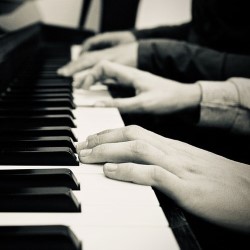Improvisational Compositions

Here is the general strategy I used for students to prepare an improvised piece for performance:
- Have a definite beginning and ending. To start out strong is very important when performing an improvisational piece. This idea is usually one simple thing repeated either in different octaves or in the same place with increasing or decreasing dynamics. A strong ending is also important so the audience can tell the song is over and the performer can confidently finish their song. Sometimes the ending is just a single note, or it can be an idea similar to the beginning of the song.
- Use an A-B-A song structure. For most of my students, the main part of their song had at least 2 parts and generally followed an A-B-A structure. This way the audience can have some familiarity to idea A and hear it again later in the song. Most of the time idea A is the more "catchy" or more quick with scale runs and single notes. Then the B part is more "anticipating" with held notes and chords.
- If playing with an accompaniment, use it as a timing device for when to switch ideas. Most of my students who use improvisation in performance have an accompaniment with it - either Garage Band, or a live person playing something together with them. For the Garage Band performers, they could predict when they should switch ideas either by listening to their background or looking at their place in the song. For the people improvising a duet together, some of them listened across to each other for cues to change ideas, and some of them had one person playing an exact accompaniment that the other could listen to and switch ideas.
I will definitely continue using improvising as a teaching tool and a performance option for my students. We even got some parents in the mix with improvising some duets!!

